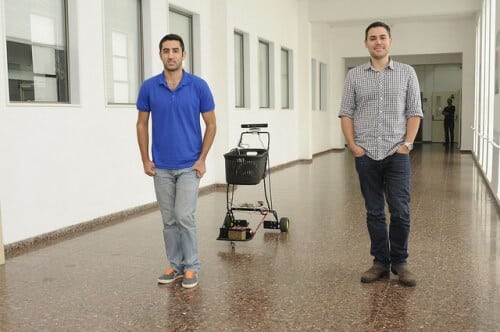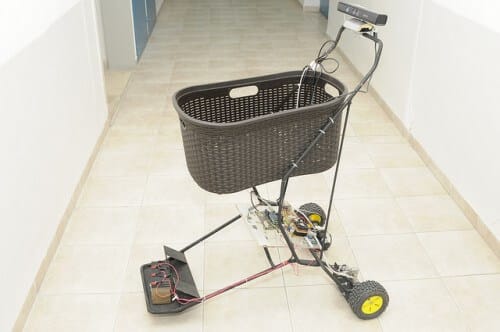Technion students have developed an algorithm that allows the shopping cart to follow the buyer without him having to touch it. They also built the cart itself

Imagine a futuristic picture: you are in a supermarket, and dozens of carts travel between the shelves independently, following the shoppers like a loyal dog, following them from the milk shelves to the bread shelves, from the vegetable shelves to the cash register. Sounds nice? Omri Elimelech and Ohad Rosnak, undergraduate students from the Faculty of Electrical Engineering at the Technion, developed such a shopping cart: a robotic cart that moves independently and follows the shopper.
Omri and Ohad, cousins and good friends since childhood, always liked to build things and understand how they work. "When we were little," says Omri, "we played a lot with engineering Legos and built robots. We really like to build things, and it was always clear to us that when we grow up we will study engineering at the Technion."
"When we had to choose a final project," Ohad adds, "it was clear to us that we would engage in a project related to robotics, and that's how we ended up in the laboratory for control, robotics and computational learning at the faculty."
The idea for the specific project came to the minds of the two following the experiences of a fan with his mother in the supermarket. "My mother likes to shop at the supermarket, loading carts, and I'm just tired of following her around the supermarket and pushing the cart, so we decided to develop an autonomous robotic shopping cart for her, which will do the work for me."
"A fan's mother was enthusiastic about the idea, and we started working on the project seriously," says Amri. "We started researching on the internet and looking for similar projects done in the past. To our surprise, we did not find any autonomously moving robotic carts. We found some carts that follow the buyer by remote control, but not a robotic cart that would follow him in a truly autonomous way."
Faculty members thought the idea for the project was a little too ambitious for an undergraduate, because it was based on real-time image processing, but the two did not sound desperate. They put a lot of thought into writing the algorithm that will allow the buyer to be identified and tracked in real time.

The two mounted a Kinect camera on the cart, which gives a good depth image and is able to identify people in the image. The camera transmits the information to the processor that runs the identification algorithm and makes sure that of all the people in the picture, the tracking will only be done after the specific customer that the cart is supposed to follow. "It's a learning system," explains Amri, "and the processor stores new information and improves performance all the time. Developing this algorithm was the main and most significant challenge in the project"
"We also made the cart ourselves," says Ohad. "We found a disassembled shopping cart in a dump, rusted and without wheels, and rebuilt it. We welded its structure so that it would be light and efficient for a robot of this type, we attached a Kinect camera, a powerful battery and a computer card to it, while taking great care in the design of the product."
Kobi Kokhi, head of the laboratory for control, robotics and computational learning at the Faculty of Electrical Engineering, guided and accompanied the students in the project. "The project received a score of 100. For us at the faculty, the process that the students go through to build themselves professionally is the significant thing, and not necessarily the final product. During the course, the students are required to research new technologies in depth, and they are exposed to entrepreneurship and product development."
"From our point of view, we succeeded in the project," Ohad and Amri conclude. "This is a student project that must continue to be worked on and improved. We believe that in the future a dedicated chip will be developed to replace the processor we used. Our product is still not perfect, but we will continue and develop it in the future."

2 תגובות
Does anyone know what degree they did? Very interesting 🙂
We need your advice in Shavit